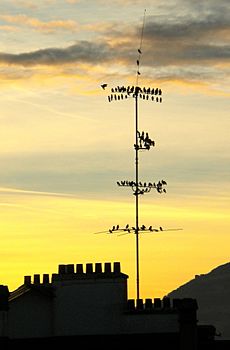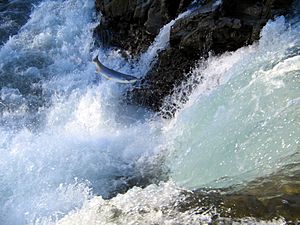Animal migration facts for kids
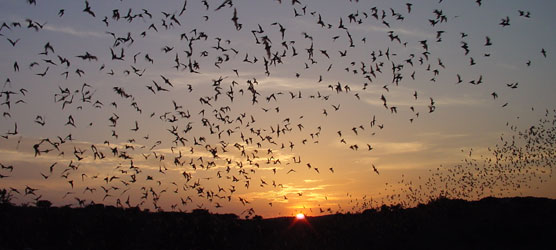
Animal migration is when animals travel long distances, usually at certain times of the year. It's the most common type of migration in nature. Animals from almost all groups migrate, including birds, mammals, fish, reptiles, amphibians, insects, and crabs.
Animals migrate for many reasons. They might be looking for better weather, more food, or a safe place to have their babies. For a movement to be called a "true migration," it usually happens every year or season. For example, birds in the Northern Hemisphere fly south for the winter. Wildebeest also move every year to find fresh grass. Sometimes, young animals like Atlantic salmon leave their birth rivers to live in the ocean.
Contents
Why Animals Migrate
Animals migrate to find what they need to survive and reproduce. This often means moving to places with more food or better weather.
Seasonal Journeys
Many animals make seasonal migrations. This means they move from one home to another at different times of the year. The amount of food and the temperature change with the seasons.
- Some animals, like Pacific salmon, swim upstream in rivers to lay their eggs. After laying eggs, they return to the ocean.
- Many birds fly to warmer places during winter. This helps them escape cold weather and find food.
Daily Movements
Some animals also migrate every day. These are shorter trips, but they are still important.
- Many animals that live in water move up and down in the water column each day. This is called "diel vertical migration." They might travel a few hundred meters.
- Some jellyfish also move horizontally a few hundred meters each day.
Tidal Movements
Animals living near the ocean use tides to move. This is called tidal migration.
- Organisms like crabs and small fish move in and out of intertidal zones as the tides rise and fall. These areas are rich in food.
- Smaller or younger animals often come out to feed during low tide. They can survive in shallow water and are safer from predators.
- Larger animals are found during high tide when the water is deeper.
Animals on the Move
Different kinds of animals migrate in different ways.
Birds
About 1,800 of the world's 10,000 bird species fly long distances each year. They do this because of the changing seasons. Many birds fly from north to south. They feed and raise their young in the northern parts of the world during summer. Then they fly hundreds or thousands of kilometers south for the winter.
- The Arctic tern has the longest migration journey of any bird. It flies from the Arctic to the Antarctic and back every year. This trip is at least 19,000 kilometers (12,000 miles) long! This means it gets to enjoy two summers each year.
- Birds use many senses to find their way. They use the sun as a compass and can even sense the Earth's magnetic fields.
Fish
Most fish stay in one area. But a few hundred species travel very long distances, sometimes thousands of kilometers.
- About 120 species of fish, including several types of salmon, move between saltwater and freshwater.
- Herring and capelin are "forage fish" that migrate across large parts of the North Atlantic. Capelin, for example, lay their eggs near Iceland. Their young then drift around Iceland. The adult fish swim north to feed and then return to Iceland.
- The "sardine run" is when billions of Southern African pilchard fish move north along the east coast of South Africa.
Insects
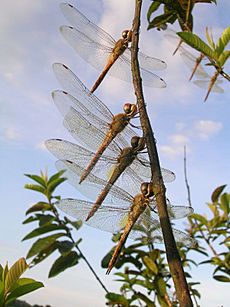
Some insects with strong wings, like locusts, certain butterflies, and dragonflies, fly long distances.
- The Pantala flavescens dragonfly makes the longest ocean crossing of any insect. It flies between India and Africa!
- In some migratory butterflies, like the monarch butterfly and the painted lady, a single butterfly doesn't complete the whole trip. Instead, they lay eggs along the way, and their children continue the journey.
Mammals
Some mammals make amazing migrations.
- Reindeer have one of the longest land migrations. They can travel as much as 4,868 kilometers (3,025 miles) each year in North America.
- Grey wolves can cover even more ground. One wolf traveled a total of 7,247 kilometers (4,503 miles) in a year.
- The Serengeti 'great migration' is a huge yearly movement of about 1.7 million wildebeest and hundreds of thousands of other large animals, like gazelles and zebra.
- Some bats also migrate long distances. The Mexican free-tailed bat travels between Oregon and southern Mexico.
- Cetaceans, which include whales, dolphins, and porpoises, also migrate. Some travel long distances between their feeding areas and their breeding areas.
- While human migration is usually about people permanently changing where they live, some old traditions fit the pattern. For example, transhumance is when herders and their animals move seasonally between mountains and valleys.
Other Animals

- Adult sea turtles travel far to lay their eggs. Young sea turtles also crawl from their nests to the ocean and swim out to sea. Young green sea turtles use Earth's magnetic field to find their way.
- The Christmas Island red crab is a land crab that migrates in huge numbers each year. Millions of them move together. They breathe with gills, so they need to stay wet. They mate on land and the females carry their eggs for two weeks. Then they go to the sea to release their eggs. The baby crabs spend a few weeks in the ocean before returning to land.
Tracking Migration
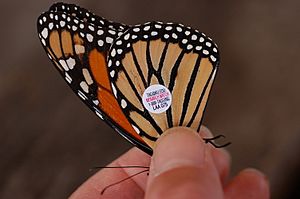
Scientists study animal migration by watching how animals move. In the past, animals were given tags, like bird rings, so they could be identified later. But this didn't show the exact path the animal took.
Now, scientists use electronic devices to track animals:
- Radio-tracking collars can be followed by radio from the ground, a vehicle, or an aircraft.
- GPS animal tracking devices send exact locations regularly. These are heavier and more expensive.
- Argos Doppler tags send signals to satellites. They can estimate an animal's location, but not as precisely as GPS.
- For small birds, scientists use geolocators. These devices record light levels as the bird flies. When the bird is caught again, the data can show where it traveled.
- Radio-tracking tags can even be put on insects like dragonflies and bees.
In Culture
Before people understood animal migration, they made up stories to explain why some animals appeared or disappeared.
- In Ancient Greece, the thinker Aristotle thought that robins turned into redstarts when summer came.
- In the Middle Ages, people believed that barnacle geese grew like fruit on trees or came from goose barnacles found on driftwood.
- Even naturalists like Gilbert White once thought that swallows might hibernate underwater, buried in mud, or in hollow trees.
See Also
 In Spanish: Migración animal para niños
In Spanish: Migración animal para niños
Images for kids


